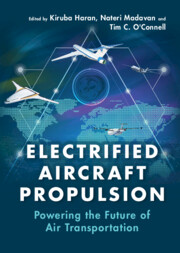Book contents
- Electrified Aircraft Propulsion
- Electrified Aircraft Propulsion
- Copyright page
- Dedication
- Contents
- Contributors
- Preface
- 1 Benefits of Electrified Propulsion for Large Aircraft
- 2 Aircraft Electric Power System Design, Control, and Protection
- 3 Megawatt-Scale Electric Machines for Electrified Aircraft Propulsion
- 4 Superconducting Machines and Cables
- 5 Conventional Power Electronics for Electrified Aircraft Propulsion
- 6 Cryogenic Power Electronics
- 7 Electrochemical Energy Storage and Conversion for Electrified Aircraft
- 8 Thermal Management of Electrified Propulsion Systems
- 9 Performance Assessment of Electrified Aircraft
- Index
- References
9 - Performance Assessment of Electrified Aircraft
Published online by Cambridge University Press: 11 May 2022
- Electrified Aircraft Propulsion
- Electrified Aircraft Propulsion
- Copyright page
- Dedication
- Contents
- Contributors
- Preface
- 1 Benefits of Electrified Propulsion for Large Aircraft
- 2 Aircraft Electric Power System Design, Control, and Protection
- 3 Megawatt-Scale Electric Machines for Electrified Aircraft Propulsion
- 4 Superconducting Machines and Cables
- 5 Conventional Power Electronics for Electrified Aircraft Propulsion
- 6 Cryogenic Power Electronics
- 7 Electrochemical Energy Storage and Conversion for Electrified Aircraft
- 8 Thermal Management of Electrified Propulsion Systems
- 9 Performance Assessment of Electrified Aircraft
- Index
- References
Summary
Most electrified aircraft propulsion (EAP) studies define a concept architecture and compute its potential benefits and key dependencies while attempting to answer the question: Can this architecture “buy its way” onto an aircraft? An important follow-on question is when will the architecture become physically and economically viable? Answering these two questions is the goal of the performance assessment process, a systematic method of analyzing the trade-offs when choosing an EAP system over a traditional one. Its methodologies and assumptions must be reasonable, and detailed comparisons to an appropriate baseline architecture must be included. This chapter outlines a systematic performance assessment process for EAP concept architectures, providing a means of deriving system-level figures of merit. Key steps in the process are identified and details are given for how they might reasonably be performed. Concepts and conclusions from earlier chapters are incorporated as needed. This serves as a guide to aircraft designers – new and old – who are beginning to delve into this exciting field and starting to explore the large design space enabled by EAP configurations.
Keywords
- Type
- Chapter
- Information
- Electrified Aircraft PropulsionPowering the Future of Air Transportation, pp. 256 - 293Publisher: Cambridge University PressPrint publication year: 2022



